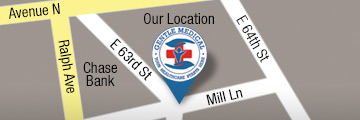Suture Removal (Removal of Stitches and Staples)
Posted by admin on August 15th, 2013

“Suture removal is a simple procedure that can be performed quickly in my office. Although it is an easy procedure, trying to remove sutures yourself is never a good idea, as pieces of stitches can be left behind and infection may occur. If the idea of having your sutures removed makes you nervous, don’t worry- the procedure is not painful and will be over before you know it!”
-Dr. Zimilevich, MD
Repair of the skin is generally achieved by either stitching (suturing) the skin closed or by using staples. If you have sutures or staples, you might be dreading having them taken out. I’m here to assure you that the procedure is quick and virtually painless in experienced hands.
Types of skin closure materials
There are two types of sutures, absorbable and non-absorbable. Absorbable sutures break down eventually (usually within a month or two) and do not have to be removed. Non-absorbable sutures, on the other hand, are used to close external wounds in the skin and must be removed after a period of time.
Staples look just like office staples. They are easy to put in and pose less risk of infection. They may be used to close scalp wounds or operative wounds, but can sometimes leave scarring.
Skin closure tapes are also sometimes used, but it can be difficult to perfectly align the wound edges using skin closure tape, and tape might not adhere very well to areas with lots of body hair or areas that are prone to sweating.
Adhesive agents (skin glue), similar to crazy glue, can also be used to close a wound, especially in children because there is no need to anesthetize the skin prior to gluing. However, skin glue cannot be used on any area of the body where the skin is required to move, such as knees and elbows.
Prior to suture or staple removal
If you have sutures or staples in place, you will have received instructions on how to care for the affected area, such as keeping the area clean and dry for the first couple of days, covering the area with a band-aid if there is bleeding or discharge, watching for signs/symptoms of infection and when to return for removal of your sutures or staples. You will need to make an appointment to come in and have your sutures or staples removed. In general, removal time for specific areas of the body are as follows (you may be given a different timeline):
- arms/legs- 10 to 14 days
- trunk- 7 to 10 days
- joints- 14 days
- scalp- 7 to 10 days
- face- varies from 3 to 7 days, depending on the area of the face

Using sterile forceps and suture scissors for suture removal.
What can I expect during the suture removal procedure?
You will be positioned comfortably so that the area with sutures or staples is easily accessible. The affected area will be cleansed to remove debris and loosen any scar tissue forming. Using sterile forceps, I will carefully pick up the knot of each suture and, using a blade or sterile scissors, I will cut the suture. I will then use the forceps to pull the suture gently to remove it fully intact. You may feel a slight tugging sensation, but it will not hurt. I will continue with each individual suture until all of them have been removed. If you have staples, I will use a special tool that resembles a wire cutter to grasp each individual staple in the center. By squeezing the handles of the tool together, the staple’s edges are bent upwards and the staple can be gently pulled straight up and out. Again, you won’t feel any pain.
Following, I will clean the wound again. I may apply adhesive strips to help hold the wound edges together for a few more days until the wound has strengthened again, or I may apply a bandage to cover and protect the wound. It depends on the size and location of the wound.
After suture/staple removal
Just because your sutures or staples are out does not mean you are off the hook as far as wound care goes! You still need to:
- leave the adhesive strips in place for approximately 5 days, or until they fall off naturally
- keep your wound dry and clean
- protect your wound from trauma for about a month, as your wound will be fragile and prone to splitting open should you suffer an injury in the same area
- protect the area from too much sun
If you need to come in for suture removal, don’t worry- the procedure is quick and painless. Be sure to call and make an appointment to come in for your suture removal well before the due date to ensure that your sutures are not left in too long, as this can make it more difficult to remove them.
Our Location

6301 Mill Lane, Brooklyn, NY 11234.
(718) 942-4600



